List of Parliamentary constituencies in Cumbria
The county of Cumbria, is divided into 6 Parliamentary constituencies - 1 Borough constituency for the City of Carlisle and 5 County constituencies.
Constituencies
† Conservative ‡ Labour ¤ Liberal Democrat
| Name | Electorate[1] | Majority[2][nb 1] | Member of Parliament[2] | Nearest opposition[2] | Electoral wards[3] | Map | ||
|---|---|---|---|---|---|---|---|---|
| Barrow and Furness | 70,158 | 5,789 | Simon Fell† | Chris Altree‡ | Barrow-in-Furness Borough Council: Barrow Island, Central, Dalton North, Dalton South, Hawcoat, Hindpool, Newbarns, Ormsgill, Parkside, Risedale, Roosecote, Walney North, Walney South. South Lakeland District Council: Broughton, Crake Valley, Low Furness & Swarthmoor, Ulverston Central, Ulverston East, Ulverston North, Ulverston South, Ulverston Town, Ulverston West. | 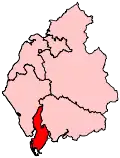 | ||
| Carlisle | 65,105 | 8,319 | John Stevenson† | Ruth Alcroft‡ | Carlisle City Council: Belah, Belle Vue, Botcherby, Burgh, Castle, Currock, Dalston, Denton Holme, Harraby, Morton, St Aidans, Stanwix Urban, Upperby, Wetheral, Yewdale. | 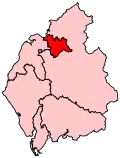 | ||
| Copeland | 61,693 | 5,842 | Trudy Harrison† | Tony Lywood‡ | Allerdale Borough Council: Crummock, Dalton, Derwent Valley, Keswick. Copeland Borough Council: Arlecdon, Beckermet, Bootle, Bransty, Cleator Moor North, Cleator Moor South, Distington, Egremont North, Egremont South, Ennerdale, Frizington, Gosforth, Harbour, Haverigg, Hensingham, Hillcrest, Holborn Hill, Kells, Millom Without, Mirehouse, Moresby, Newtown, St Bees, Sandwith, Seascale. | 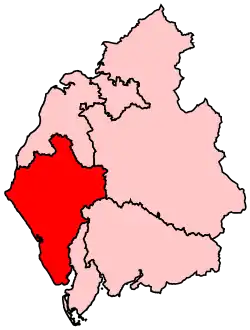 | ||
| Penrith and The Border | 67,555 | 18,519 | Neil Hudson† | Sarah Williams‡ | Allerdale Borough Council: Warnell, Wigton. Carlisle City Council: Brampton, Great Corby and Geltsdale, Hayton, Irthing, Longtown & Rockcliffe, Lyne, Stanwix Rural. Eden District Council: Alston Moor, Appleby (Appleby), Appleby (Bongate), Askham, Brough, Crosby Ravensworth, Dacre, Eamont, Greystoke, Hartside, Hesket, Kirkby Stephen, Kirkby Thore, Kirkoswald, Langwathby, Lazonby, Long Marton, Morland, Orton With Tebay, Penrith Carleton, Penrith East, Penrith North, Penrith Pategill, Penrith South, Penrith West, Ravenstonedale, Shap, Skelton, Ullswater, Warcop. | 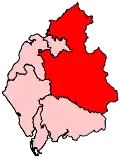 | ||
| Westmorland and Lonsdale | 67,789 | 1,934 | Tim Farron¤ | James Airey† | South Lakeland District Council: Arnside & Beetham, Burneside, Burton & Holme, Cartmel, Coniston, Crooklands, Grange, Hawkshead, Holker, Kendal Castle, Kendal Far Cross, Kendal Fell, Kendal Glebelands, Kendal Heron Hill, Kendal Highgate, Kendal Kirkland, Kendal Mintsfeet, Kendal Nether, Kendal Oxenholme, Kendal Parks, Kendal Stonecross, Kendal Strickland, Kendal Underley, Kirkby Lonsdale, Lakes Ambleside, Lakes Grasmere, Levens, Lyth Valley, Milnthorpe, Natland, Sedbergh, Staveley-in-Cartmel, Staveley-in-Westmorland, Whinfell, Windermere Applethwaite, Windermere Bowness North, Windermere Bowness South, Windermere Town. | 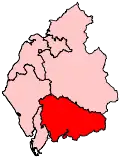 | ||
| Workington | 61,370 | 4,176 | Mark Jenkinson† | Sue Hayman‡ | Allerdale Borough Council: All Saints, Aspatria, Boltons, Broughton St Bridget's, Christchurch, Clifton, Ellen, Ellenborough, Ewanrigg, Flimby, Harrington, Holme, Marsh, Moorclose, Moss Bay, Netherhall, St John's, St Michael's, Seaton, Silloth, Solway, Stainburn, Wampool, Waver, Wharrels. | 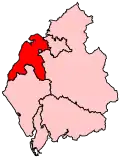 | ||
From 2010
| Name[nb 2] | Pre-2010 Boundaries | Post-2010 Boundaries |
|---|---|---|
 Parliamentary constituencies in Cumbria |
 Post-2010 Boundaries | |
Proposed boundary changes
The Boundary Commission for England submitted their final proposals in respect of the Sixth Periodic Review of Westminster Constituencies (the 2018 review) in September 2018. Although the proposals were immediately laid before Parliament they were not brought forward by the Government for approval. Accordingly, they did not come into effect for the 2019 election which took place on 12 December 2019, and which was contested using the constituency boundaries in place since 2010.
Under the terms of the Parliamentary Voting System and Constituencies Act 2011, the Sixth Review was based on reducing the total number of MPs from 650 to 600 and a strict electoral parity requirement that the electorate of all constituencies should be within a range of 5% either side of the electoral quota.
On 24 March 2020, the Minister of State for the Cabinet Office, Chloe Smith, issued a written statement to Parliament setting out the Government's thinking with regard to parliamentary boundaries.[4] Subsequently, the Parliamentary Constituencies Act 2020[5] was passed into law on 14 December 2020. This formally removed the duty to implement the 2018 review and set out the framework for future boundary reviews. The Act provided that the number of constituencies should remain at the current level of 650, rather than being reduced to 600, while retaining the requirement that the electorate should be no more than +/- 5% from the electoral quota.
The Act specified that the next review should be completed no later than 1 July 2023 and the Boundary Commission formally launched the 2023 Review on 5 January 2021.[6] See 2023 Periodic Review of Westminster constituencies for further details.
Results history
Primary data source: House of Commons research briefing - General election results from 1918 to 2019[7]
2019
The number of votes cast for each political party who fielded candidates in constituencies comprising Cumbria in the 2019 general election were as follows:
| Party | Votes | % | Change from 2017 | Seats | Change from 2017 |
|---|---|---|---|---|---|
| Conservative | 143,615 | 52.5% | 5 | ||
| Labour | 79,402 | 29.0% | 0 | ||
| Liberal Democrats | 39,426 | 14.4% | 1 | 0 | |
| Greens | 4,223 | 1.5% | 0 | 0 | |
| Brexit | 3,867 | 1.4% | new | 0 | 0 |
| Others | 3,044 | 1.2% | 0 | 0 | |
| Total | 273,577 | 100.0 | 6 |
Percentage votes
| Election year | 1983 | 1987 | 1992 | 1997 | 2001 | 2005 | 2010 | 2015 | 2017 | 2019 |
|---|---|---|---|---|---|---|---|---|---|---|
| Conservative | 46.7 | 48.1 | 46.3 | 33.5 | 39.5 | 37.9 | 39.4 | 40.7 | 48.8 | 52.5 |
| Labour | 31.2 | 33.1 | 36.9 | 45.8 | 39.1 | 34.8 | 30.8 | 29.8 | 36.2 | 29.0 |
| Liberal Democrat1 | 21.8 | 18.7 | 16.0 | 16.5 | 19.2 | 23.4 | 24.3 | 13.3 | 11.8 | 14.4 |
| Green Party | - | * | * | * | * | * | 0.6 | 3.4 | 0.5 | 1.5 |
| UKIP | - | - | - | * | * | * | 2.2 | 12.6 | 2.3 | * |
| Brexit Party | - | - | - | - | - | - | - | - | - | 1.4 |
| Other | 0.3 | 0.1 | 0.8 | 4.1 | 2.3 | 3.9 | 2.8 | 0.2 | 0.4 | 1.2 |
11983 & 1987 - SDP-Liberal Alliance
* Included in Other
Seats
| Election year | 1983 | 1987 | 1992 | 1997 | 2001 | 2005 | 2010 | 2015 | 2017 | 2019 |
|---|---|---|---|---|---|---|---|---|---|---|
| Conservative | 3 | 3 | 2 | 2 | 2 | 1 | 2 | 2 | 3 | 5 |
| Labour | 3 | 3 | 4 | 4 | 4 | 4 | 3 | 3 | 2 | 0 |
| Liberal Democrat1 | 0 | 0 | 0 | 0 | 0 | 1 | 1 | 1 | 1 | 1 |
| Total | 6 | 6 | 6 | 6 | 6 | 6 | 6 | 6 | 6 | 6 |
11983 & 1987 - SDP-Liberal Alliance
Maps
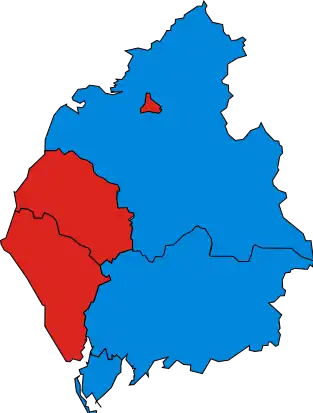 1983
1983 1987
1987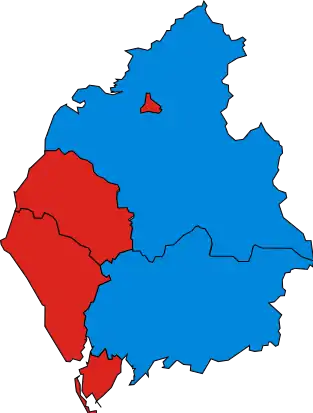 1992
1992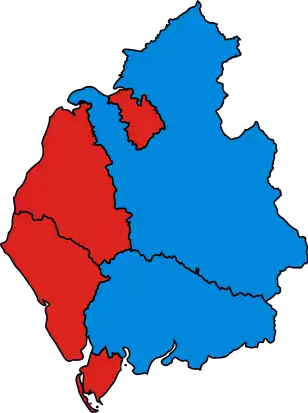 1997
1997 2001
2001 2005
2005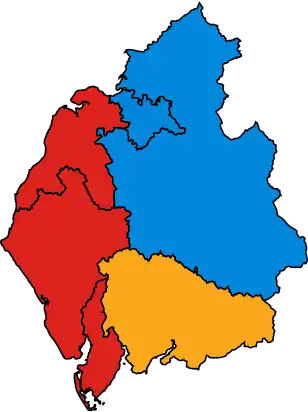 2010
2010 2015
2015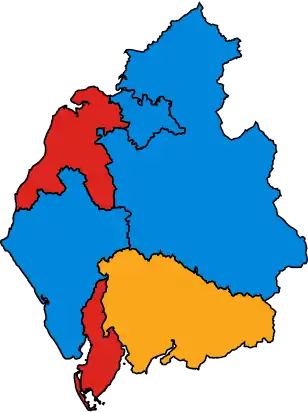 2017
2017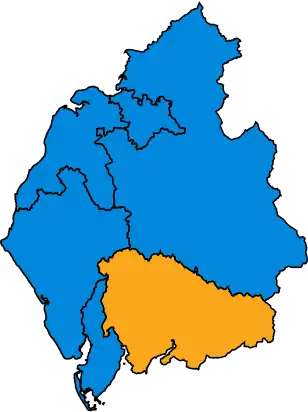 2019
2019
Historical representation by party
A cell marked → (with a different colour background to the preceding cell) indicates that the previous MP continued to sit under a new party name.
1885 to 1918
Conservative Independent Conservative Labour Liberal Liberal Unionist Speaker
| Constituency | 1885 | 86 | 1886 | 91 | 1892 | 95 | 1895 | 1900 | 05 | 1906 | 06 | Jan 1910 | Dec 1910 | 13 | 15 | 16 |
|---|---|---|---|---|---|---|---|---|---|---|---|---|---|---|---|---|
| Carlisle | Ferguson | Gully | → | Chance | Denman | |||||||||||
| Eskdale | Allison | C. W. H. Lowther | Howard | C. W. H. Lowther | ||||||||||||
| Cockermouth | Valentine | Lawson | Randles | Lawson | Randles | Lawson jnr | Bliss | |||||||||
| Appleby | W. Lowther | Savory | Rigg | Jones | Sanderson | H. C. Lowther | ||||||||||
| Egremont | Pennington | Ainsworth | Duncombe | Bain | Fullerton | Grant | ||||||||||
| Whitehaven | Cavendish-Bentinck | Bain | Little | Helder | Burnyeat | Jackson | Richardson | |||||||||
| Kendal | Taylour | Bagot | Stewart-Smith | Bagot | Weston | |||||||||||
| Penrith | Howard | → | J. Lowther | → | ||||||||||||
1918 to 1950
Coalition Liberal (1918-22) / National Liberal (1922-23) Conservative Independent Parliamentary Group Labour Liberal Speaker
| Constituency | 1918 | 21 | 1922 | 1923 | 1924 | 26 | 1929 | 1931 | 1935 | 1945 |
|---|---|---|---|---|---|---|---|---|---|---|
| Westmorland | Weston | Stanley | Fletcher-Vane | |||||||
| Cumberland North | C. W. Lowther | → | Howard | Graham | Roberts | |||||
| Penrith and Cockermouth | J. Lowther | H. C. Lowther | Collison | Dixey | Dower | |||||
| Carlisle | Carr | Middleton | Watson | Middleton | Spears | Grierson | ||||
| Whitehaven | Grant | Duffy | Hudson | Price | Nunn | Anderson | ||||
| Workington | Cape | Peart | ||||||||
1950 to 1983
| Constituency | 1950 | 1951 | 1955 | 59 | 1959 | 1964 | 1966 | 1970 | Feb 1974 | Oct 1974 | 76 | 1979 |
|---|---|---|---|---|---|---|---|---|---|---|---|---|
| Westmorland | Fletcher-Vane | Jopling | ||||||||||
| Penrith and the Border | Scott | Whitelaw | ||||||||||
| Carlisle | Hargreaves | Johnson | Lewis | |||||||||
| Whitehaven | Anderson | Symonds | Cunningham | |||||||||
| Workington | Peart | Page | Campbell-Savours | |||||||||
1983 to present
Conservative Independent The Independents Labour Liberal Democrats
| Constituency | 1983 | 83 | 1987 | 1992 | 1997 | 2001 | 2005 | 2010 | 2015 | 17 | 2017 | 18 | 19 | 2019 |
|---|---|---|---|---|---|---|---|---|---|---|---|---|---|---|
| Westmorland and Lonsdale | Jopling | Collins | Farron | |||||||||||
| Penrith and the Border | Whitelaw | Maclean | Stewart | → | Hudson | |||||||||
| Barrow and Furness | Franks | Hutton | Woodcock | → | → | Fell | ||||||||
| Carlisle | Lewis | Martlew | Stevenson | |||||||||||
| Copeland | Cunningham | Reed | Harrison | |||||||||||
| Workington | Campbell-Savours | Cunningham | Hayman | Jenkinson | ||||||||||
See also
- List of Parliamentary constituencies in the North West (region)
- List of United Kingdom Parliament constituencies
Notes
- The majority is the number of votes the winning candidate receives more than their nearest rival.
- BC denotes borough constituency, CC denotes county constituency.
References
- Baker, Carl; Uberoi, Elise; Cracknell, Richard (2020-01-28). "General Election 2019: full results and analysis". House of Commons Library. Cite journal requires
|journal=(help) - "Constituencies A-Z - Election 2019". BBC News. Retrieved 2020-04-23.
- "The Parliamentary Constituencies (England) Order 2007". Office of Public Sector Information. Crown copyright. 13 June 2007. Retrieved 7 November 2009.
- "Update: Strengthening Democracy:Written statement - HCWS183". UK Parliament. Retrieved 2020-04-20.
- "Parliamentary Constituencies Act 2020".
- "2023 Review launched | Boundary Commission for England". Retrieved 2021-01-08.
- Watson, Christopher; Uberoi, Elise; Loft, Philip (2020-04-17). "General election results from 1918 to 2019". House of Commons Library. Cite journal requires
|journal=(help)